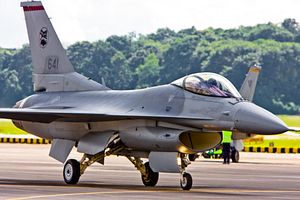Last week, the U.S. Department of Defense notified U.S. lawmakers of an intent to supply eight Block-52 F-16 fighters to Pakistan. The possibility of the United States supplying Pakistan with eight new F-16s was made public in November 2015, but has run into stiff opposition in the U.S. Congress. In the days prior to the notification, Senator Bob Corker, chairman of the Senate Foreign Relations Committee, wrote Secretary of State John Kerry to convey his opposition of the use of U.S. taxpayer money to fund the delivery of F-16s to Pakistan and expressed his belief that Pakistan needed to do more to target militant groups in the region.
The U.S. first mooted the supply F-16s to Pakistan in the early 1980s and under very similar circumstances: President Ronald Reagan exercised executive authority, despite opposition from Congress, to agree to the sale of F-16s to Pakistan in order incentivize Pakistan’s assistance to the United States in Afghanistan. However, with the Soviet Union’s defeat in Afghanistan in 1989, U.S. reliance on Pakistan quickly waned. The Pressler Amendment came into effect in 1990, as a result of which the United States slapped sanctions on Pakistan on account of the country’s undeclared nuclear weapons program and canceled the supply of approximately 30 F-16s that Pakistan had already purchased.
The September 11, 2001, terrorist attacks in New York and Washington, D.C., refocused U.S. interest in the region and established Pakistan as a central cog in the U.S. war against al-Qaeda and the Taliban. For its commitment to support U.S. efforts in Afghanistan, the George W. Bush administration agreed to release the previously blocked F-16s to Pakistan, refurbish the country’s existing F-16 aircraft, and sell Pakistan new F-16 Block-50/52 aircraft worth approximately $3 billion.
Last week’s statement announcing the prospective sale of eight F-16s to Pakistan follows a well-established pattern of the U.S. attempting to induce Pakistani action through incentivization. A few observations can be made to provide context around the proposed supply of F-16s to Pakistan.
First and perhaps most obviously, the announcement comes at a time when the U.S. again seeks Pakistan’s cooperation in bringing the Taliban to the negotiating table with the Afghanistan government. A previous attempt at negotiations last year, under the aegis of Pakistan, ended abruptly when it was revealed that the Taliban’s reclusive leader, Mullah Omar, had been dead for over a year.
It remains to be seen as to whether or not the Pakistanis wield sufficient influence over the Taliban, which is in the throes of an internal leadership struggle following the announcement of Mullah Omar’s death. However, the U.S. no doubt feels that it must do what it can to coax Pakistani action on the Afghan front. The thinking of the Obama administration appears to be that a promise to supply of F-16s, a key demand of Pakistan’s for some time, might induce favorable action from Pakistan.
Second, U.S. concerns over Pakistan’s nuclear weapons program remain unabated. Indeed, even as the Obama administration appeared ready to supply the eight F-16s to Pakistan, the State Department’s deputy spokesman underscored U.S. concerns over the reported rapid growth of Pakistan’s nuclear weapons stockpile and its induction of the so-called tactical nuclear weapons (TNWs) to its arsenal. The U.S. has reportedly considered offering Pakistan a civil nuclear deal in exchange for its commitment to roll back its TNWs. It is not inconceivable then that the supply of F-16 fighter aircraft could be part of a broader U.S. approach to elicit commitments from Pakistan on Afghanistan and on nuclear security. Indeed, the Carter administration contemplated the sale of F-16s to Pakistan with the hope that it could convince Pakistan to scale back its nuclear weapons program.
Third, the announcement underscores the transactional nature of the U.S.-Pakistan relationship, despite the rather curious language in the notification, which describes Pakistan’s as a “strategic partner.” The United States’ past dealings with Pakistan show that although Pakistan desires a more broad-based strategic relationship with the U.S. in order to effectively counter India, the relationship continues to be anything but strategic and is unlikely to transform into one anytime soon.
Fourth, despite considerable strategic convergence between the United States and India in the Indo-Pacific, the announcement highlights that a gulf still exists between the two countries on Pakistan. The Indian government is unhappy with the sale, which will augment Pakistan’s nuclear delivery capabilities, and chided the U.S. for its perceived lack of sensitivity toward the potential threat the sale presents to India’s security. Many in India view the United States’ inducements as incentivizing Pakistan’s bad behavior in the region.
And lastly, domestically, the announcement further brings into focus the schism between the Obama Administration and Congress on a host of issues, including foreign policy. The Obama Administration has since moved Congress for approval of the deal, but it is likely that it will run into opposition from lawmakers of both political parties. The Obama Administration could potentially invoke the national security waiver to override Congressional resistance over the supply of the F-16s to Pakistan. There is likely a sense of urgency in the Obama Administration and anxiety in Islamabad to conclude the deal prior to the U.S presidential elections in November.
There are other, less significant factors that may influence the U.S. decision to supply the F-16s to Pakistan, including U.S. concerns over Pakistan’s sustained and significant drift into China’s sphere of influence. But ultimately, the notification follows a familiar pattern in U.S.-Pakistan relations, with the U.S. attempting to incentivize Pakistani compliance or action on key U.S. national security interests. The results of these inducements have historically been mixed, at best, or have failed. Of course, if the history of the U.S.-Pakistan relationship is any guide, it will be worth waiting to see if any of the eight F-16s eventually do actually end up in Pakistan, the recent notification notwithstanding.

































